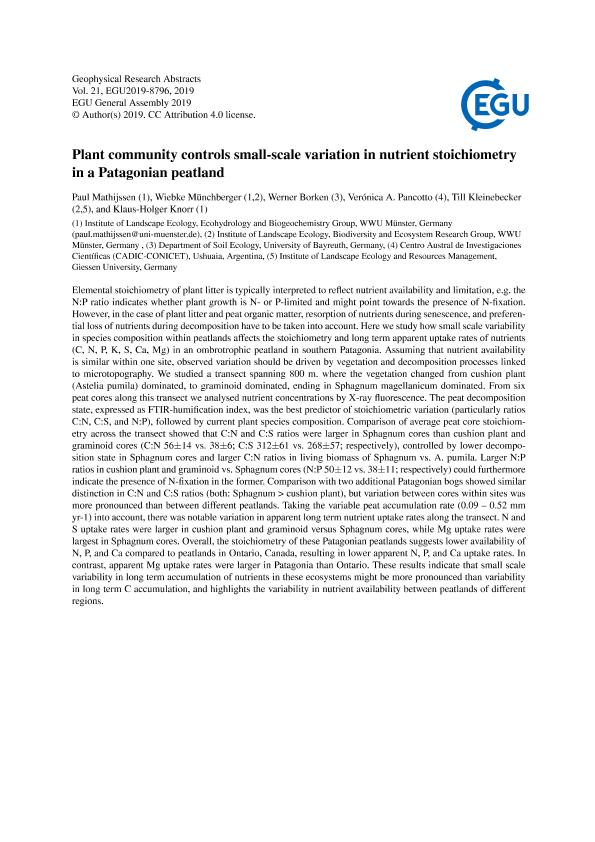Mostrar el registro sencillo del ítem
dc.contributor.author
Mathijssen, Paul
dc.contributor.author
Münchberger, Wiebke
dc.contributor.author
Borken, Werner
dc.contributor.author
Pancotto, Veronica Andrea

dc.contributor.author
Kleinebecker, Till
dc.contributor.author
Knorr, Klaus Holger
dc.date.available
2023-04-21T19:31:49Z
dc.date.issued
2020
dc.identifier.citation
Plant community controls small-scale variation in nutrient stoichiometry in a Patagonian peatland; 21th European Geosciences Union General Assembly; Viena; Austria; 2019; 1-1
dc.identifier.issn
2391-5447
dc.identifier.uri
http://hdl.handle.net/11336/195027
dc.description.abstract
Elemental stoichiometry of plant litter is typically interpreted to reflect nutrient availability and limitation, e.g. the N:P ratio indicates whether plant growth is N- or P-limited and might point towards the presence of N-fixation. However, in the case of plant litter and peat organic matter, resorption of nutrients during senescence, and preferential loss of nutrients during decomposition have to be taken into account. Here we study how small scale variability in species composition within peatlands affects the stoichiometry and long term apparent uptake rates of nutrients (C, N, P, K, S, Ca, Mg) in an ombrotrophic peatland in southern Patagonia. Assuming that nutrient availability is similar within one site, observed variation should be driven by vegetation and decomposition processes linked to microtopography. We studied a transect spanning 800 m. where the vegetation changed from cushion plant (Astelia pumila) dominated, to graminoid dominated, ending in Sphagnum magellanicum dominated. From six peat cores along this transect we analysed nutrient concentrations by X-ray fluorescence. The peat decomposition state, expressed as FTIR-humification index, was the best predictor of stoichiometric variation (particularly ratios C:N, C:S, and N:P), followed by current plant species composition. Comparison of average peat core stoichiometry across the transect showed that C:N and C:S ratios were larger in Sphagnum cores than cushion plant and graminoid cores (C:N 56±14 vs. 38±6; C:S 312±61 vs. 268±57; respectively), controlled by lower decomposition state in Sphagnum cores and larger C:N ratios in living biomass of Sphagnum vs. A. pumila. Larger N:P ratios in cushion plant and graminoid vs. Sphagnum cores (N:P 50±12 vs. 38±11; respectively) could furthermore indicate the presence of N-fixation in the former. Comparison with two additional Patagonian bogs showed similar distinction in C:N and C:S ratios (both: Sphagnum > cushion plant), but variation between cores within sites was more pronounced than between different peatlands. Taking the variable peat accumulation rate (0.09 ? 0.52 mm yr-1) into account, there was notable variation in apparent long term nutrient uptake rates along the transect. N and S uptake rates were larger in cushion plant and graminoid versus Sphagnum cores, while Mg uptake rates were largest in Sphagnum cores. Overall, the stoichiometry of these Patagonian peatlands suggests lower availability of N, P, and Ca compared to peatlands in Ontario, Canada, resulting in lower apparent N, P, and Ca uptake rates. In contrast, apparent Mg uptake rates were larger in Patagonia than Ontario. These results indicate that small scale variability in long term accumulation of nutrients in these ecosystems might be more pronounced than variability in long term C accumulation, and highlights the variability in nutrient availability between peatlands of different regions.
dc.format
application/pdf
dc.language.iso
eng
dc.publisher
Copernicus
dc.rights
info:eu-repo/semantics/openAccess
dc.rights.uri
https://creativecommons.org/licenses/by-nc-sa/2.5/ar/
dc.subject
peatland
dc.subject
nutrients
dc.subject
microambients
dc.subject.classification
Ecología

dc.subject.classification
Ciencias Biológicas

dc.subject.classification
CIENCIAS NATURALES Y EXACTAS

dc.title
Plant community controls small-scale variation in nutrient stoichiometry in a Patagonian peatland
dc.type
info:eu-repo/semantics/publishedVersion
dc.type
info:eu-repo/semantics/conferenceObject
dc.type
info:ar-repo/semantics/documento de conferencia
dc.date.updated
2023-02-16T10:15:15Z
dc.journal.volume
21
dc.journal.pagination
1-1
dc.journal.pais
Austria

dc.journal.ciudad
Vienna
dc.description.fil
Fil: Mathijssen, Paul. University of Münster; Alemania
dc.description.fil
Fil: Münchberger, Wiebke. University of Münster; Alemania
dc.description.fil
Fil: Borken, Werner. University of Bayreuth; Alemania
dc.description.fil
Fil: Pancotto, Veronica Andrea. Consejo Nacional de Investigaciones Científicas y Técnicas. Centro Austral de Investigaciones Científicas; Argentina
dc.description.fil
Fil: Kleinebecker, Till. Justus Liebig Universitat Giessen; Alemania
dc.description.fil
Fil: Knorr, Klaus Holger. University of Bayreuth; Alemania
dc.relation.alternativeid
info:eu-repo/semantics/altIdentifier/url/https://meetingorganizer.copernicus.org/EGU2019/EGU2019-8796.pdf
dc.conicet.rol
Autor

dc.conicet.rol
Autor

dc.conicet.rol
Autor

dc.conicet.rol
Autor

dc.conicet.rol
Autor

dc.conicet.rol
Autor

dc.coverage
Internacional
dc.type.subtype
Conferencia
dc.description.nombreEvento
21th European Geosciences Union General Assembly
dc.date.evento
2019-04-07
dc.description.ciudadEvento
Viena
dc.description.paisEvento
Austria

dc.type.publicacion
Journal
dc.description.institucionOrganizadora
Asamblea General de European Geosciences Union
dc.source.libro
Geophysical Research Abstracts
dc.source.revista
Geophysical Research Abstracts
dc.date.eventoHasta
2019-04-12
dc.type
Conferencia
Archivos asociados
